This works great with molds:
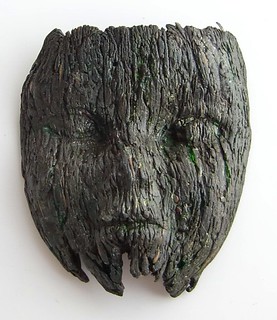
As a surface texture for faux wood (adapted from the twig tutorial of Randee M. Ketzel)
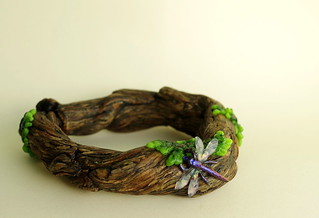
This can make great stone effects (the clear stone is playdoh cane, the green is my first try at the Diva Designs Masterful Faux Made Easy tutorial). I used molds:
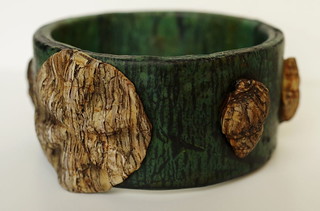
Or more subtle ivory or bone effects:
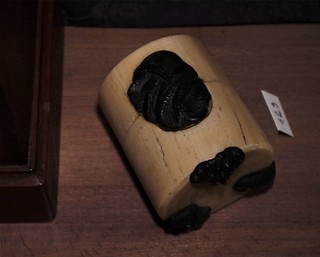
This one is a bit different, I just added a few partial sheets of playdoh in a classic ivory cane made of stacked sheets of Kato polyclay.
Disclaimer: I have had no problems baking playdoh at the temperatures at which polymer clay is normally baked. However, I do not know how it behaves at higher temperatures, or when baked for a very long time (more than an hour or two). Use caution like you would for any inclusion material.
Choose a mix of colors for your cane, with high contrast: the Firefly and Liverworts bracelet is high contrast and lighter clay, the face mold is chocolate and black clay, and there is clearly insufficient contrast.
Break it into smaller pieces, and put it in a mixer dedicated to polymer clay (a fine grater works too, but is muuuuch longuer). Break up pieces of the playdoh clay. Chop well.
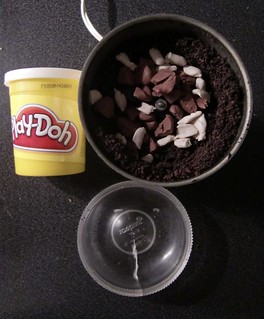
Proportions:
I have tried up to half playdoh. It works great with 1-2mm slices and a solid clay backing or support.
The face, the Nightmare Catcher and the awélé are half playdoh-half Fimo.
The Firefly and Liverworts bracelet is approximatively one third of playdoh for two third of polymer clay (Fimo).
The Sea Shell Stone bracelet is maybe one sixth of playdoh for five sixth of Fimo.
The Kato ivory box has very little playdoh (1/20th maybe).
Compact the small pieces together. This one is half playdoh, half polymer clay, and had me very worried. It came out fantastic.

You can actually stop here, and have a very textured stone effect (like some volcanic stones), but I would not advise to do this with a mix with a too high playdoh content.
Flatten the blob, cut it and stack it (keeping the "fibers" all going in the same direction), flatten it again, cut, stack and repeat. Don't use the pasta machine, the playdoh adheres to the rolers, and the whole layer is not cohesive enough, and might fall in pieces.
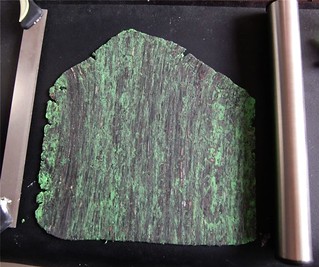
End by making a higher stack, with grain as fine as you want. For these canes, a contrasting color of playdoh is good, so you can see how fine the layers are (here, the playdoh is white, and the clay chocolate and black; in the other cane, brown and black clay, green playdoh).

Cut your stack in slices (I found 2mm is a good compromise for texture depth, but I have gotten away with finer slices (1mm, like in the firefly bracelet). Use the slices in molds, or as veneer for any polymer clay shape.

The technique is fantastic with silicone molds. Add a pure polymer clay backing to ensure sructural integrity, especially if the playdoh content is high: if the playdoh layer is large, the polymer clay layers might not be touching enough in the slices, and it will come appart at soaking. Use liquid clay between the two, but beware, as liquid clay soaks up in the playdoh after a while, and it is not water soluble, so it cannot be washed away anymore.
Unbaked, just out of the mold:
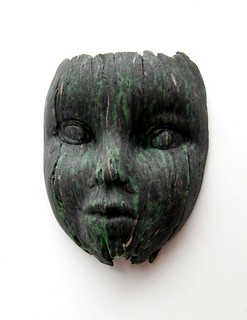
Bake as usual. After baking, soak in water, leave for a few hours, brush with and old toothbrush to get as much water-soluble clay away as possible. Soak again, repeat.
When you are satisfied with the depth of the texture, stop and dry it.
Baked, with the playdoh washed away:
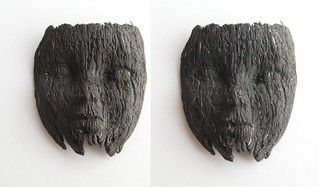
Antique with acrylic paint and oil paint, and rebake to bond/dry if necessary. Both acrylic paint and oilpaint bond very, very well with playdoh, and will cover any remains in the cracks of the clay.
The pieces stand up to wear well if they have been baked correctly, so at least at the recommended temperature for the brand, or a bit higher. See the great posts of Ginger Davis Allman at The Blue Bottle Tree.
Linked posts (some to come):
Playdoh cane

Hollow beads using water-soluble child clay

Shell beads

I believe in sharing. I have learned most of what I know about polymer clay, and many other subjects, from the web, so giving back seems the right thing to do.
You are very welcome to use these techniques, and even sell the result. However, I would much appreciate a mention and a link if you use these techniques.
And I would love to see anything you have done with this...
Aucun commentaire:
Enregistrer un commentaire